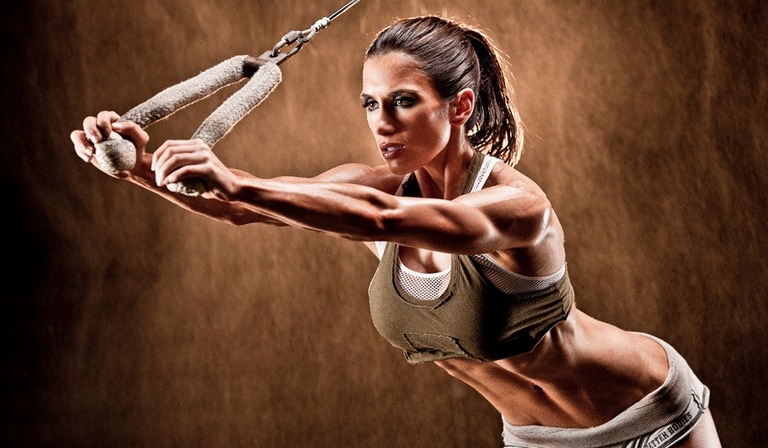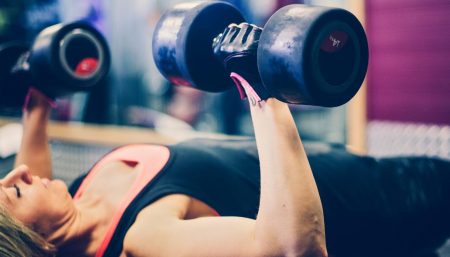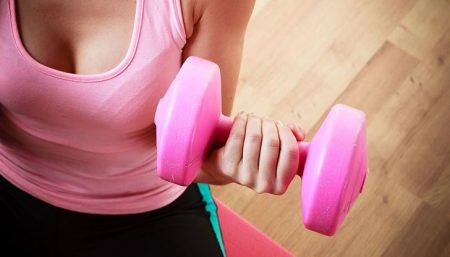Weight loss by women mostly produces muscle and bone loss. A combination of low total calories, aerobic exercise, and decreased protein intake will cause the body to literally strip muscle off of your body. Even with more muscle, a woman won’t look muscular unless she has very low body fat levels. Women naturally have more body fat than men, which is what gives them their feminine curves.
Below are 10 commonly held misconceptions in the sport of bodybuilding :
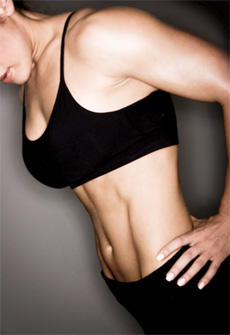 1. Women are just not biologically suited for muscular development
1. Women are just not biologically suited for muscular development
Females are convinced to halt the development of their bodies so that they do not get too big or muscular . What may prevent women from taking advantage of their natural physiology is not their bodies, it is the social rules that encourage them to remain inactive and weak. We won’t know what women are truly capable of until they stop putting their bodies through a constant disciplining regime of some sort whether is be in terms of caloric restriction and/or excessive exercise with the end goal being to tear down rather than build up their physiques. Given the same opportunities, the gap between male and female athletes is much narrower than they would like to believe, dependent upon social forces rather than biological determinants.
By really lifting weights and stressing your muscles you will increase your lean mass, and since it is this lean mass (muscle tissue) that burns fat, you will have the capacity to burn morefat even at rest. Combining this with a moderate amount of cardiovascular activity (not three step classes in a row) will turn your body into a fat burning machine.
2. You should only rest 45 seconds in between sets
That’s true if you’re trying to improve cardiovascular health or lose some bodyfat. But in order to build muscle, you need to allow enough time for the muscle to recuperate fully (i.e. let the lactic acid buildup in your muscles dissipate and ATP levels build back up). In order to make muscles grow, you have to lift the heaviest weight possible, thereby allowing the maximum number of muscle fibers to be recruited. If the amount of weight you lift is being limited by the amount of lactic acid left over from the previous set, you’re only testing your ability to battle the effects of lactic acid. In other words, you’re trying to swim across a pool while wearing concrete overshoes. When training heavy, take [at least!] two and three minutes between your sets. Notice I said, “when training heavy.” The truth is, you can’t train heavy all the time. Periodization calls for cycling heavy workouts with less intense training sessions in an effort to keep the body from becoming over-trained.
 3. Anyone can be a successful competitive bodybuilder
3. Anyone can be a successful competitive bodybuilder
As in any professional sport, the athletes that rise to the top have been genetically advantaged to excel in that particular contest. In bodybuilding, you either have it or you don’t and while great genetics doesn’t guarantee you a successful career, it does determine what the final product looks like. In the end, it is the individuals that do the most with what they’ve got that usually come out on top.
4. If you do hundreds of sit-ups a day, you will eventually achieve a narrow, washboard-type midsection.
There is no such thing as spot-reduction. Doing thousands and thousands of sit-ups will give you tight abdominal muscles, but they will do nothing to rid your midsection of fat. Thigh adductorand abductor movements will give women’s thighs more firmness, but they will do nothing to rid the area of fat, or what is commonly called cellulite. Nothing will rid the body of fat, unless it is a carefully-orchestrated reduction in your daily energy intake; in other words, if you burn more calories than you ingest (or do that in conjunction with a nutrient partitioning agent).
5. Women need to train differently than men
On a microscopic level, there is virtually no difference between the muscle tissue of men and the muscle tissue of women. Men and women have different levels of the same hormones, and that’s what is responsible for the difference in the amount of muscle a man can typically put on and the amount of muscle a woman can typically gain. There is absolutely no reason why either should train differently than the other sex, provided they have the same goals.
The only difference in training might be as a result of cultural, sexual preferences. A woman might desire to develop her glutes a little more so she looks better in a pair of jeans. Conversely, a man might want to build his lats a little more so that he fits the cultural stereotype of a virile man.
6. Consuming foods high in sugar before training provides your body with extra energy to sustain workouts
 Simple sugars like sucrose don’t need to be broken down by the body’s enzymes to be used as energy like complex carbohydrates do. Therefore, they elicit a rapid release of insulin, the hormone that regulates blood-sugar levels. The trouble is, the sudden, rapid influx of sugar into the system causes the body to release insulin in what must be considered a haphazard method, i.e. the amount released is usually more than what’s needed to metabolize the sugar.
Simple sugars like sucrose don’t need to be broken down by the body’s enzymes to be used as energy like complex carbohydrates do. Therefore, they elicit a rapid release of insulin, the hormone that regulates blood-sugar levels. The trouble is, the sudden, rapid influx of sugar into the system causes the body to release insulin in what must be considered a haphazard method, i.e. the amount released is usually more than what’s needed to metabolize the sugar.
Consequently, your blood sugar often temporarily drops to a point that is actually lower than it was before you had the sugar, which might cause you to become more exhausted much earlier than it normally would. Your body is then forced to dip into its glycogen reserves in order to correct the imbalance.
To ensure that you have enough energy to complete a workout, eat nutrient- rich foods with low glycemic indices (those that elicit a smooth, steady stream of sugar into the bloodstream) like barley, lentils or beans.
7. Female bodybuilders are trying to turn themselves into men
This couldn’t be further from the truth. If anything, women that transform their physiques are attempting to become better women, not men. I attribute this thinking to a society that continues to be disturbed by their level of physical development due to commonly held misconceptions of gender and being unable (or unwilling) to separate an athletic pursuit from a woman’s sexuality. Some will always see female athletes in sexual terms and use them explain what they don’t understand. If a woman with muscle is more of a man, is a man without muscle more of a woman?
8. Weight training decreases muscle flexibility
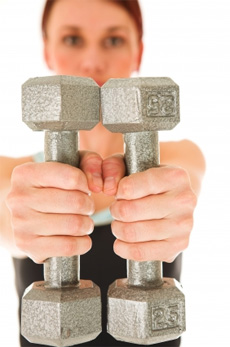 Training with weights causes your muscles to get tight and hinders flexibility and, consequently, athletic performance. If anything, when done properly (slowly and using a complete range of motion), weight training increases flexibility. Many athletes engage in weight training in order to improve their performance in their chosen sport — witness Evander Hollyfield or any number of track athletes, basketball players, or gymnasts; the list goes on and on.
Training with weights causes your muscles to get tight and hinders flexibility and, consequently, athletic performance. If anything, when done properly (slowly and using a complete range of motion), weight training increases flexibility. Many athletes engage in weight training in order to improve their performance in their chosen sport — witness Evander Hollyfield or any number of track athletes, basketball players, or gymnasts; the list goes on and on.
This lie might have been fueled from the feeling of ‘tightness’ that accompanies an intense workout. If the workout was intense and a sufficient number of muscle fibers were recruited and microscopically damaged, then even the normal tonus (the normal amount of contraction experienced by a relaxed muscle) is more than enough to cause a feeling of pain and tightness. The tightness is compounded by the ‘tugging’ of the tendons on the muscles. Stretching, however, would do much to alleviate this tightness, and stretching is a recommended part of any athletic pursuit.
The muscle flexibility seems to be determined more by a complex relationship of tendon length and strength and nervous system efficiency as opposed to muscular strength, and weight training could, possibly, upset this delicate balance.
I don’t know if there are any more or less lesbians in female bodybuilding than there are in any other sport or in society in general. I do know that most women who build competitive physiques are doing so for themselves, some even do it for the men they are already involved with; husbands, boyfriends, coaches and trainers. Some think that if women aren’t focused on appealing sexually to men that she must be attracted to women, but not every pursuit is motivated by sex. The bottom line for many rests on athleticism, competition and personal achievement, not about scoring more numbers to beef up a little black book.
 10. If you stop working out, your muscle will turn into fat
10. If you stop working out, your muscle will turn into fat
Muscle can no sooner turn to fat than gold can turn into lead. Muscle is made up of individual cells–living, ‘breathing’ cells that undergo all kinds of complex metabolic processes. Fat cells are simply storage packets of lipids. The possibility of one changing into another is alike to the football in your storage closet turning into your Uncle Sam.
If you stop working out, if you stop applying resistance to your muscles on a consistent basis, they will simply adapt to the new condition. In other words, they’ll shrink. If the degree of inactivity or immobilization is severe, the muscles will shrink faster than the surrounding skin, and a temporary condition of loose skin might be experienced, but that too would remedy itself with time.
By using state-of-the-art training principles, consuming a nutrient-rich diet, and by getting proper amounts of rest, almost every person can make incredible changes in his or her physique.
Related Links
- Top 10 Truth About Flat Abs
- Keep Your Fat Furnace Working
- What to Expect From Weight Training
- Top 10 Answers to Cellulite
- Top 10 Foods That Help You Lose Weight
Disclaimer
The Content is not intended to be a substitute for professional medical advice, diagnosis, or treatment. Always seek the advice of your physician or other qualified health provider with any questions you may have regarding a medical condition.
